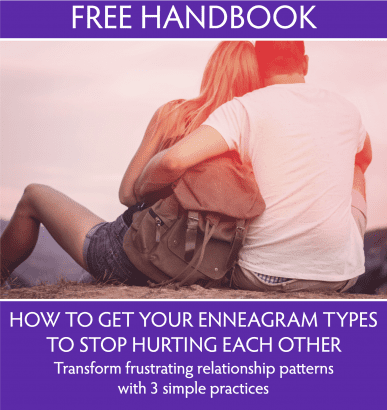“Cool!”
“Yuck.”
Many people who meet the Enneagram and discover their core point of view can find it a simultaneous affirmation and a punch in the gut. It’s as though someone has held up a mirror to our core strategy for managing the world, and we both resonate and agree with the description, and feel exposed and unmasked about things we like to steer away from. It’s common to focus on one or the other of these feelings. We experience a YES and a NO in response to it.
YES
It’s typical when people first learn the Enneagram that they start noticing the types in action everywhere, including their own. It’s common to hear declarations like, “Oh, that’s because I’m a Two,” meaning either that they are giving themselves an excuse to operate out of their habit, or that they’ve taken the description of their pattern to define themselves. Neither of these approaches lead to the sense of liberation that the Enneagram invites.
When I say YES to my type’s description, it can be an act of empowerment – where I recognize its accuracy and feel like I can orient toward it in an appreciative way. Each enneatype brings particular gifts to the world, and when I understand which gift comes most easily through me, it can feel meaningful and fulfilling to operate with that understanding. A friend, who orients to the world through the point of view of type Five, really loves being of use in research and being a resource to others in thinking things through objectively. She doesn’t have to try at this, and it feels useful to her and to others much of the time.
Another way I might say YES to my type’s description might strengthen my identification with my type. Whether we admit it or not, all of us pretty much think our type has the best perspective, and that most of the rest of humanity is walking around as an inferior version of us. Even the most modest types have this going on inside. A Four might think, “No one can feel as deeply about this as I can. Their interests are all shallow and crass.” While I may look dejected in saying it, I’m actually getting the payoff of feeling better-than.
My mother once mused how great the world would be if everyone were her same enneatype, since that way others would be operating according to the same (superior) expectations and values that she was. My instant response was “No!” Then we’d all be caught in the same kind of way, like allowing only one color of the rainbow. But secretly we’ve all had a similar wish- “Why doesn’t the other just do it the way I would?”
YES, BUT—
It’s also natural to want to “shine up” our ego once we learn about its patterns. As a Three, I might want to maximize my strengths and strategize how to reduce or eliminate my less “attractive” traits or behaviors. For example, trying hard to be patient in order to be a “better me” is simply turning the go-ahead energy of Three inward. This feeds the mechanisms that keep fueling the type structure- in this case the need to succeed at self-awareness, to be approved of, and to not show failure. And while it may help me to access some patience in the moment, I will ultimately be just as likely to be impatient and tempted to drive change in the future.
By trying to improve our types, we can even develop a sense of more inner limitation by telling ourselves we can’t or shouldn’t express the “downsides” of the pattern. As a Nine, I might inwardly scold myself for forgetting my priorities, which leaves me feeling less motivated and more discouraged. Or we might tell ourselves that we must deliver our strengths— as a One I might assume that I should lead on the next project because I care to do a more thorough job on it than the others in my group. This will likely reinforce my sense of obligation and increase my resentment toward others. Then I’m back where I started again.
NO
When we first learn our enneatypes there can also be a strong sense of rejection. “No! Don’t put me in a box. I’m much more than that!” I know that, deep down, I’m far more than the constructs of my personality. And while this is ultimately true, the “No!” reaction is most commonly from the personality itself. My ego doesn’t want to be called out and disarmed. It doesn’t want the apple cart of my worldview upset.
We can also say NO to our type by being critical of its arising in our lives. This is actually another way of trying to control or improve our types. As a Six, I might notice that I’m focusing on the worst case scenario with my coworkers, and inwardly scold myself for being a downer, resolving to take a more positive approach. This is natural when we learn about the “downsides” of our enneatypes. We start to be able to see how they are not working well for us in many cases. But to police ourselves about our autopilot is confounding. At Six, when I notice my worst-case thinking, there are a number of things I can do to help myself access more resources or lean into a sense of faith. But judging myself for my architecture doesn’t tend to bring on a sense of the well-being needed in the situation.
SO WHAT THEN?
It can be confusing to know what to do with what Tom Condon has called the “dump truck load of insight” that the Enneagram can deliver us. Do I take my type on? Do I try to transcend it? Do I scrutinize myself with it? Do I try to slay the dragon of ego? Do I just receive it as another cute personality test?
I guess the answer is that I might do any or all of those things. And most of these approaches will keep reinforcing the skewed beliefs of our types that have us feeling unsatisfied already.
It makes sense that acknowledging our enneatypes would bring up both the YES and the NO in us. YES- I accept that this is my core strategy in life. NO- I don’t want to identify with this as defining me.
In working with our types, acceptance is best understood as simple acknowledgment. It does not mean I agree with the thoughts my pattern helped to conjure, rather that I admit and accept that they are there, and that they are a predictable pattern. Ideally this is done with a neutral or observing stance, not a critical or evaluative one. Acceptance means allowing our inner observer to witness and recognize that we have particular grooves we prefer and that we find it hard to choose otherwise.
Today it was a priority for me to sit down and write this post, and I noticed myself doing a number of other “important tasks” first. I am aware that this is a classic pattern for my type. I lead with type Nine, and have daily experiences of my attention going to the “inessentials,” or deferring my priorities. In the past, I might have had a NO reaction, and become judgmental or discouraged with myself that I wasn’t as on task as I wanted to be. I might have been frustrated that all these other things were pulling my attention off of my getting to my own priorities. I might have had a YES reaction by either excusing my behavior since Nines are just this way, or in feeling bad that I’m just a lazy Nine who isn’t efficient (positive identification with the downside).
Instead, due to the gifts of the Enneagram and the mindfulness it invites me into, I was able to watch the distractions arise. I was able to stay with myself in the actions I chose, and to realize I was choosing them to varying degrees out of my habit of attention. I was able to accompany myself back to a place where I could attempt, anew, to act on my priority.
This process included the yes-no dynamic of my relationship to my type, but in a different way. I said inwardly, “Yes, Nineness is arising in me and affecting my behavior.” And I also said “No, I’m not going to allow my Nineness (or my rejection of it) to be the dictator in this moment.”
Perhaps it’s more accurate to say that I said YES to my type’s existence, and YES to my Self that is not limited by the type.
What would it be like to live the next few moments of your day as a true witness to your process? Being really there, but not really buying the party line?
Michael Singer said, “The day you decide that you are more interested in being aware of your thoughts than you are in the thoughts themselves— that is the day you will find your way out.”
Feel free to share your experiences with positive and negative identification with your type below.







3 Responses
Sarah, Simple and complex, yes and no, I am glad you noticed, contemplated and said yes to your writing this post today.
+A
Very good to hear that the yes/no is a common reaction and that there are ways to move toward a wholeness that both accepts our types, and doesn’t limit us by types. Now, I’d like to hear more about how to work with those juicy edges.
Yes- the juicy edges! More to come on that– stay tuned. In the meantime, noticing them is a plenty big task. Simply noticing (not following or resisting) our type patterns can be Jedi level work… especially when we’re reactive.